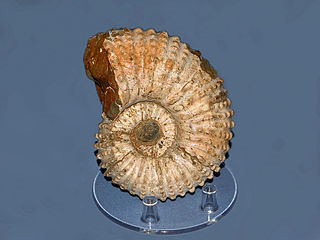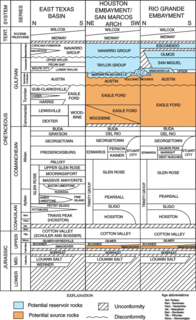| Mal Paso Formation Stratigraphic range: Late Albian | |
|---|---|
| Type | Formation |
| Location | |
| Country | Mexico |
The Mal Paso Formation is a geologic formation in Mexico. It preserves fossils dating back to the Cretaceous period, Late Albian. [1]

Chubutisaurus is a genus of dinosaur from the Early Cretaceous Period. It lived in South America. It is classified as a sauropod, specifically one of the titanosaurs. The type species, Chubutisaurus insignis, was described by del Corro in 1975. Its fossils were found in the Cerro Barcino Formation, Albian stage, about 110 million years ago. Chubutisaurus had a more robust radius than Venenosaurus. In 2010 Gregory Paul gave a length of 18 meters (59 ft) and a weight of 12 tonnes. Thomas Holtz estimated its length at 23 meters (75.5 ft) in 2012.

Polyptychodon is a genus of pliosaurid found in Middle-Late Cretaceous marine deposits in southern England and Patagonia. It has been considered a nomen dubium in a 2016 review.

Douvilleiceras is a genus of ammonites from the Middle to Late Cretaceous. Its fossils have been found worldwide, in Africa, Asia, Europe, and North and South America.

Hamadasuchus is an extinct genus of sebecian crocodylomorph. Fossils have been found from the Kem Kem Formation outcropping in southeastern Morocco. These beds date back to the Albian and Cenomanian stages of the Late Cretaceous. It was first assigned to the family Trematochampsidae. Diagnostic features of the genus include its lateromedially compressed and serrated teeth. It was deep-snouted and had a slightly heterodont dentition with three distinct tooth morphologies present from sections of the lower jaw.
Coilopoceras is a compressed, involute, lenticular ammonitid from the Cretaceous, with a narrow venter and raggedy ammonitic suture; type of the Coilopoceratidae, a family in the Acanthoceratoidea of the suborder Ammonitina.

Desmoceras is a genus of ammonites belonging to the family Desmoceratidae. These cephalopods were fast-moving nektonic carnivores. They lived in the Early Cretaceous; Albian epoch.

Araripemydidae is a family of freshwater aquatic turtles belonging to the order Pleurodira, known from the Early Cretaceous of South America and Africa. The family contains two recognised monotypic genera, Araripemys and Taquetochelys, from the Santana Group of Brazil and the Elrhaz Formation of Niger, respectively, which date to the Aptian-Albian stages of the Early Cretaceous. They are consider to be the most basal lineage within the Pelomedusoides. They are thought to have been specialised suction feeders. Laganemys was named in 2013 but was later determined to be synonymous with Taquetochelys.
The De Queen Formation, formerly known as the DeQueen Limestone Member is a Mesozoic geological formation located in southwestern Arkansas and southeastern Oklahoma in the United States. Fossil sauropod and theropod tracks have been reported from the formation. It preserves fossils dating back to the Cretaceous period, particularly the Albian age.

The Comanche Peak Limestone is a geologic formation in Texas. It preserves fossils dating from the Early Cretaceous (Albian).
The Goodland Limestone or Goodland Formation is a geologic formation in Arkansas and Texas. It preserves fossils dating back to the Cretaceous period.
The Rosario Group is a Late Cretaceous geologic group in southwestern California and northwestern Baja California (Mexico). In older literature it was named Rosario Formation.
The Beaver Mines Formation is a stratigraphic unit of Early Cretaceous (Albian) age in the Western Canada Sedimentary Basin that is present in southwestern Alberta and southeastern British Columbia, Canada. It was established by G.B. Mellon in 1967 who named it for the hamlet of Beaver Mines, Alberta. It contains a variety of plant fossils.
The Boca Roja Formation is a geologic formation located at Huizachal Canyon in Tamaulipas, northeastern Mexico. The formation preserves fossils that were found in rocks dating back to the Cretaceous period. Another dinosaur-bearing formations is the Late Campanian El Gallo Formation. The Boca Roja Formation contains the oldest dinosaur remains found in Mexico.

The Olmos Formation is a geologic formation in Mexico. It preserves fossils of plants, hadrosaurs, ceratopsians, tyrannosaurs and the turtle Palauchelys dating back to the Cretaceous period.
The El Abra Formation is a geologic formation in Mexico. It preserves fossils dating back to the Cretaceous period.
The La Caja Formation is a geologic formation in Mexico. It preserves fossils datiting from the Kimmeridgian to the lower Berriasian. La Caja Formation is widespread in northeastern and central Mexico and known for their abundant and diverse well-preserved ammonites. It was deposited in hemipelagic conditions, and predominantly consists of siliclastic sediments, including marl, with limestone. It is laterally equivalent to the La Casita Formation, which represent more proximal facies. The ichthyosaurs Ophthalmosaurus icenicus and Parrassaurus yacahuitztli, metriorhynchid Cricosaurus saltillensis and the giant pliosaur "Monster of Aramberri" are known from the formation.

The La Casita Formation is a geologic formation in Mexico. It preserves fossils dating back to the Kimmeridgian to lowermost Berriasian. It is laterally equivalent to the La Caja Formation and the Pimienta Formation. The ichthyosaurs Jabalisaurus and Acuetzpalin are known from the formation, as well as the metriorhynchid Dakosaurus and indeterminate pliosaurs.
The Pimienta Formation is a geologic formation in Mexico. It preserves fossils dating back to the Tithonian-Berriasian. The formation is considered laterally equivalent to the La Casita Formation. The Metriorhynchid Cricosaurus vignaudi is known from the formation.
The Carstone Formation is a geologic formation in England. It preserves fossils dating back to the Albian stage of the Cretaceous period. It predominantly consists of "greenish-brown, thick-bedded, cross-bedded, oolitic ferruginous sandstone".
The Poudingue Ferrugineux is a geologic formation in France. It preserves fossils dating back to the Albian stage of the Cretaceous period. It predominantly consists of conglomerate, deposited in shallow marine conditions. It is exposed at Cap de la Hève at Le Havre, Normandy. The dinosaur Normanniasaurus is known from the formation.